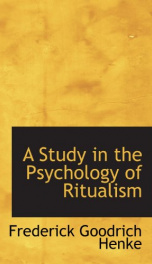a study in the psychology of ritualism

Purchase of this book includes free trial access to www.million-books.com where you can read more than a million books for free. This is an OCR edition with typos. Excerpt from book: - A ( CHAPTER II GENERAL CHARACTERISTICS OF RITUALISM A rite or ceremony is the observance of some formal act or series of acts in the manner prescribed by custom or authority, and from the point of view of functional psychology must be considered as a type of overt reaction performed for the purpose of control. In the case of the Intichiuma ceremony described in the last chapter, the purpose is control of the food situation. The totemic ceremonies described constitute a part of the initiation ceremonies1 in the Arunta tribe, and are intimately connected with matters of sex and social organization. As designed for control, the ceremony has subjective and objective aspects. Both are invariably present, though often in varying degrees. This brings us to a consideration of first importance. The ceremony is always a social reaction. There is always implicit or explicit reference to other selves, be they real or imagined. To divide rites into communal and personal2 is to distinguish on a superficial basis. Even such a supposedly individual rite as that of naming the child always implies a relation to others. The name is given by others. It is given to mark the child as a member of a certain group, to distinguish it from other members of the group, to designate its relation to society at large, and last but not least, to insure more adequate control of the individual by the group. Thus viewed, this rite, which Brinton catalogues under "personal" rites, naturally comes to take its place as a communal rite. It certainly would be quite as muchso as sacrifice, which he calls a communal rite; for here the individual may have done nothing more than make himself unclean,3 and be sacrificing to remove the uncleanness. 'A. W. Howitt has a significant paragraph on the initiation ce... --This text refers to an alternate Paperback edition.
Info about the book
Author:
Series:
Unknown
ISBN:
1419150847
Rating:
2.5/5 (2)Your rating:
0/5
Languge:
English
Users who have this book
Users who want this book
What readers are saying
What do you think? Write your own comment on this book!
write a commentif you like a study in the psychology of ritualism try:
Other books by this author
Do you want to exchange books? It’s EASY!
Get registered and find other users who want to give their favourite books to good hands!


